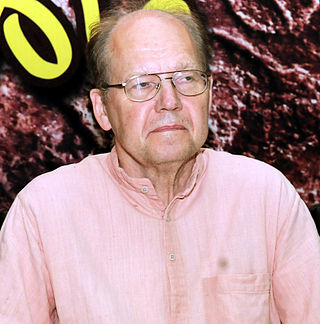Related Research Articles

The Indo-Aryan languages are a branch of the Indo-Iranian languages in the Indo-European language family. As of the early 21st century, they have more than 800 million speakers, primarily concentrated in India, Pakistan, Bangladesh, Nepal, Sri Lanka, and Maldives. Moreover, apart from the Indian subcontinent, large immigrant and expatriate Indo-Aryan–speaking communities live in Northwestern Europe, Western Asia, North America, the Caribbean, Southeast Africa, Polynesia and Australia, along with several million speakers of Romani languages primarily concentrated in Southeastern Europe. There are over 200 known Indo-Aryan languages.
Gāndhārī is the modern name, coined by scholar Harold Walter Bailey, for a Prakrit language found mainly in texts dated between the 3rd century BCE and 4th century CE in the region of Gandhāra, located in the northwestern Indian subcontinent. The language was heavily used by the former Buddhist cultures of Central Asia and has been found as far away as eastern China, in inscriptions at Luoyang and Anyang.

The Dardic languages or Hindu-Kush Indo-Aryan languages, are a group of several Indo-Aryan languages spoken in northern Pakistan, northwestern India and parts of northeastern Afghanistan.

Kalasha is an Indo-Aryan language spoken by the Kalash people, in the Chitral District in Pakistan. There are an estimated 5,000 speakers of Kalasha. It is an endangered language and there is an ongoing language shift to Khowar.
Imra was the chief creator deity of the Nuristani people before their conversion to Islam. Imra was believed to be the creator of the earth. With his breath, it was believed, he created the three other main deities of the pantheon: Mon, Gish and Bagisht.

Shina is an Indo-Aryan language spoken by the Shina people. In Pakistan, Shina is the major language in Gilgit-Baltistan spoken by an estimated 1,146,000 people living mainly in Gilgit-Baltistan and Kohistan. A small community of Shina speakers is also found in India, in the Guraiz valley of Jammu and Kashmir and in Dras tehsil of the Kargil district of Ladakh. Outliers of Shina language such as Brokskat is found in Ladakh, Kundal Shahi in Azad Kashmir, Palula and Sawi in Chitral, Ushojo in the Swat Valley and Kalkoti in Dir.

Bangani is an Indo-Aryan language spoken in parts of Uttarkashi district in the west of the Garhwal region of Uttarakhand, India. It has been described either as a member of the Western Pahari language group, or as a dialect of the Central Pahari Garhwali language. It shares between one half and two thirds of its basic vocabulary with neighbouring varieties of Garhwali and with the Western Pahari languages of Jaunsari and Sirmauri.

Asko Parpola is a Finnish Indologist, current professor emeritus of South Asian studies at the University of Helsinki. He specializes in Sindhology, specifically the study of the Indus script.

George "Sjors" van Driem is a Dutch linguist associated with the University of Bern, where he is the chair of Historical Linguistics and directs the Linguistics Institute.

Torwali is an Indo-Aryan language mainly spoken in the Bahrain and Chail areas of the Swat District in Pakistan. The language and other non-Pashtun communities are often referred to as "Kohistani" which is a name given by the Swat Pashtuns. Fredrik Barth says "The Pathans call them, and all other Muhammadans of Indian descent in the Hindu Kush valleys, Kohistanis". The Torwali language is said to have originated from the pre-Muslim communities of Swat. It is the closest modern Indo-Aryan language still spoken today to Niya, a dialect of Gāndhārī, a Middle Indo-Aryan language spoken in the ancient region of Gandhara.
Gawri (ګاوری), also known as Kalami (کالامي), or Bashkarik, is an Indo-Aryan language spoken in Swat Kohistan region in the upper Swat District and in the upper Panjkora river valley of Upper Dir District, Khyber Pakhtunkhwa, Pakistan.

The Brokpa, sometimes referred to as Minaro, are a small ethnic group mostly found in the union territory of Ladakh, India around the villages of Dha and Hanu. Some of the community are also located across the Line of Control in Baltistan, Pakistan in the villages around Ganokh. They speak an Indo-Aryan language called Brokskat. The Brokpa are mostly Vajrayana Buddhist while some are Muslim.

Indigenous Aryanism, also known as the Indigenous Aryans theory (IAT) and the Out of India theory (OIT), is the conviction that the Aryans are indigenous to the Indian subcontinent, and that the Indo-European languages radiated out from a homeland in India into their present locations. It is a "religio-nationalistic" view on Indian history, and propagated as an alternative to the established migration model, which considers the Pontic–Caspian steppe to be the area of origin of the Indo-European languages.

Indus Kohistani is an Indo-Aryan language spoken in the former Kohistan District of Pakistan. The language was referred to as Maiyã (Mayon) or Shuthun by early researchers, but subsequent observations have not verified that these names are known locally.

Richard Keith Sprigg was a British linguist who specialised in the phonology of Asian languages. Sprigg was educated under J. R. Firth and was a member of the first generation of professional British linguists. Also as a consequence Sprigg was an advocate of the prosodic phonological method of Firth. Sprigg worked on several Tibeto-Burman languages including Lepcha, and various Tibetan dialects. He taught for many years at the School of Oriental and African Studies, and retired to Kalimpong, West Bengal, India with his wife Ray, granddaughter of David Macdonald the author of The Land of the Lama and 20 Years in Tibet, until her death.
Sawi, Savi, or Sauji, is an endangered Indo-Aryan language spoken in northeastern Afghanistan and north-western Pakistan. It is classified as a member of the Shina language cluster within the Dardic subgroup.

Anoop Chandola is an American linguist-anthropologist, originally from Pauri, where he was raised in a priestly Brahmin family. Though his father and uncles broke their ancestral polygamous tradition he suffered from the aftereffects of polygamy.
Tirahi is a nearly extinct if not already extinct Indo-Aryan language spoken in a few villages in the southeast of Jalalabad in the Nangarhar Province of eastern Afghanistan. It is spoken by older adults, who are likewise fluent in Pashto.
The Torwali people are an Indo-Aryan ethnolinguistic group located in the Swat district of Pakistan. The Torwali people have a culture that values the telling of folktales and music that is played using the sitar. They speak an Indo-Aryan language called Torwali.
The Inner–Outer hypothesis of the subclassification of the Indo-Aryan language family argues for a division of the family into two groups, an Inner core and an Outer periphery, evidenced by shared traits of the languages falling into one of the two groups. Proponents of the theory generally believe the distinction to be the result of gradual migrations of Indo-Aryan speakers into India, with the inner languages representing a second wave of migration speaking a different dialect of Old Indo-Aryan, overtaking the first-wave speakers in the center and relegating them to the outer region.
References
- ↑ Zoller, Claus Peter. "Claus Peter Zoller - Department of Culture Studies and Oriental Languages". University of Oslo. University of Oslo. Retrieved 13 September 2020.
- ↑ Leavitt, John (2000). "On the Complexity of Oral Tradition: A reply to Claus Peter Zoller's review essay 'Oral Epic Poetry in the Central Himalayas'" (PDF). European Bulletin of Himalayan Research. 18: 58. Retrieved 13 September 2020.